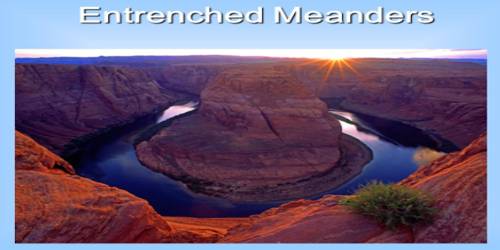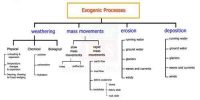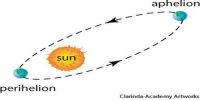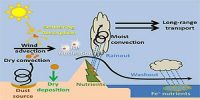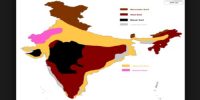Incised or Entrenched Meanders
In streams that flow rapidly over steep gradients, normally erosion is concentrated on the bottom of the stream channel. Also, in the case of steep gradient streams, lateral erosion on the sides of the valleys is not much when compared to the streams flowing on low and gentle slopes. Because of active lateral erosion, streams flowing over gentle slopes develop sinuous or meandering courses. As the stream erodes downwards, its customary meandering outline will remain as a deep valley known as an incised meander or entrenched meander. It is common to find meandering courses over floodplains and delta plains where stream gradients are very gentle. But very deep and wide meanders can also be found cut in hard rocks. Rivers in the Colorado Plateau, the Kentucky River Palisades in central Kentucky, and streams in the Ozark Plateau are noted for these incised meanders. Such meanders are called incised or entrenched meanders (Figure).
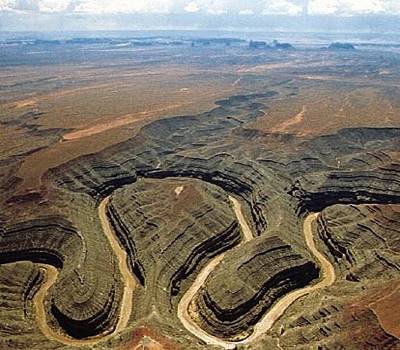
A meander is a pattern of river flow, not a landform characteristic. Incised meanders are meanders which are particularly well developed and occur when a river’s base level has fallen giving the river a large amount of vertical erosion power, allowing it to downcut. There are two types of incised meanders, entrenched meanders, and ingrown meanders. Incised Meanders form during the youth phase of the river. Now, with the course of time as Mountains and Plateaus rise, the meandering course of these rivers starts upright erosion and Incised meanders get shaped. So, they mostly happen in the Highlands rather than in plain areas. Incised meanders are also formed via the same process as the meanders.
Entrenched meanders are symmetrical and form when the river down cuts particularly quickly. Meander loops develop over original gentle surfaces in the initial stages of development of streams and the same loops get entrenched into the rocks normally due to erosion or slow, continued uplift of the land over which they start. Meanders are extensive loops or bend in the center and lower path of the river caused by rivers developing enlarged sinuosity downstream. They widen and deepen over time and can be found as deep gorges and canyons in hard rock areas. They form through a mixture of factors. These factors can be summarized as intrinsic and extrinsic factors. Intrinsic factors relate to the river’s endeavor to equilibrium its energy, velocity, and discharge. Extrinsic factors relate to the channel slope and channel unevenness. They give an indication of the status of original land surfaces over which streams have developed.
